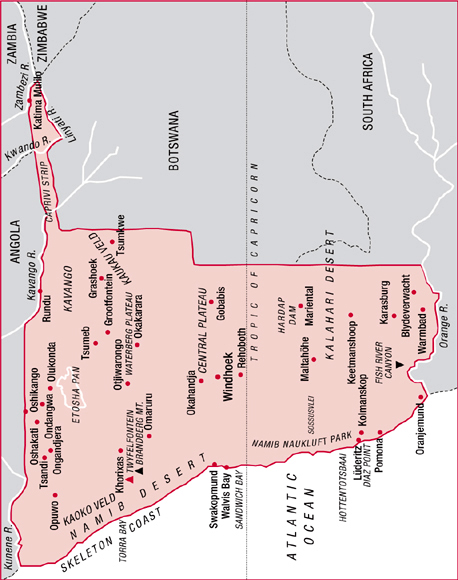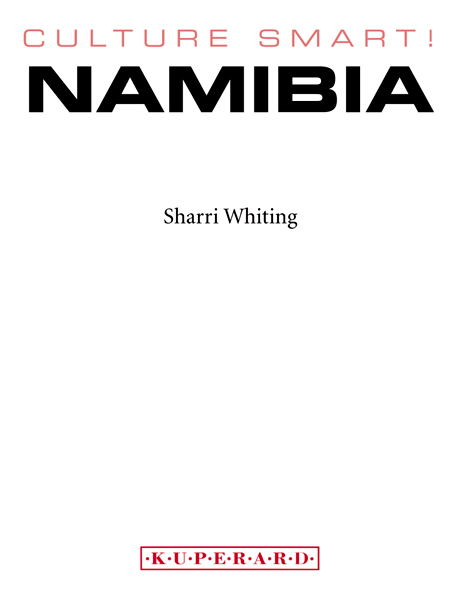First published in Great Britain 2008
by Kuperard, an imprint of Bravo Ltd
59 Hutton Grove, London N12 8DS
Tel: +44 (0) 20 8446 2440 Fax: +44 (0) 20 8446 2441
www.culturesmart.co.uk
Inquiries:
Culture Smart! is a registered trademark of Bravo Ltd
Copyright 2008 Kuperard
All rights reserved. No part of this publication may be reprinted or reproduced, stored in a retrieval system, or transmitted in any form or by any means without prior permission in writing from the publishers.
Series Editor Geoffrey Chesler
eISBN: 978-1-85733-618-4
British Library Cataloguing in Publication Data
A CIP catalogue entry for this book is available from the British Library
Images by courtesy of the author.
Images by courtesy of Namibia Tourism at .
Images Brian McMorrow.
v3.1
About the Author
SHARRI WHITING is an international consultant and lecturer, with an MSc in communications management from Simmons College, Boston. Her work has taken her to the American University of Rome, Leiden University, the European School of Economics, and the University of Texas, among others. She has written widely on issues facing executives and dual-career couples working abroad.
Sharri spent four years in Namibia and has written about the country for Air Namibias Flamingo, Travel News Namibia, and for major American publications. She was a guest lecturer at the University of Namibia, head judge for the Namibian Business Woman of the Year Awards, and a speaker before the Namibian Business and Professional Womens Association. She also writes about food, wine, and travel, and wrote the Top Ten Guide to Rome (2001). She is married to Piero De Masi, former Ambassador of Italy to Namibia. They live in Italy and the USA, and spend several weeks a year in Namibia.
The Culture Smart! series is continuing to expand.
For further information and latest titles visit
www.culturesmart.co.uk
The publishers would like to thank CultureSmart!Consulting for its help in researching and developing the concept for this series.
CultureSmart!Consulting creates tailor-made seminars and consultancy programs to meet a wide range of corporate, public-sector, and individual needs. Whether delivering courses on multicultural team building in the USA, preparing Chinese engineers for a posting in Europe, training call-center staff in India, or raising the awareness of police forces to the needs of diverse ethnic communities, it provides essential, practical, and powerful skills worldwide to an increasingly international workforce.
For details, visit www.culturesmartconsulting.com
CultureSmart!Consulting and CultureSmart! guides have both contributed to and featured regularly in the weekly travel program Fast Track on BBC World TV.
contents
Map of Namibia

introduction
Imagine standing on a single spot in a land so vast and empty that it is possible that no human being has ever stood there before. You will experience a magical sense of isolation, of empowerment, of freedom, and of communion with the environment. This is the key to understanding Namibians, for it is both the celebration of their natural surroundings and the challenge of living in a harsh terrain that make them who they are.
With a huge landmass, Namibias population is one of the least dense on earth. A little more than two million people, representing fourteen tribes, races, and ethnic groups, share this land, which has some of the most unusual natural resources in the world. The majority live in the north, along the Namibian-Angolan border, or in the center of the country in the capital city of Windhoek. The rest live on private and communal farms and in the smaller towns dotted around the country.
Regardless of where they live and who their ancestors were, Namibians have many things in common, the most important being their commitment to conservation of the countrys distinct and diverse topography: gravel plains juxtapose with an ocean of sand dunes, edged by the Namib and Kalahari deserts, punctuated by forests and savannas, plateaus and mountain ranges, and fringed by the Skeleton Coast.
Namibians take pride in their country, which only became an independent democracy in 1990. There is a strong sense of collaboration when it comes to daily life. The mix of cultures is reflected in the faces on the streetsOvambo, German, South African, Chineseas well as by the colorful traditional dress of the Herero and Himba, by German architecture, and South African food and wines. You will hear Oshivambo, Afrikaans, and German spoken, in addition to English.
Tribal and ethnic traditions are important, not only to those in the countryside, but also to city dwellers who want to pass their heritage on. In the cities, you will find modern buildings and state of the art technology, while in small towns or in the bush time seems to have stopped a hundred years agoexcept that even in the most remote areas there may be cell phones and computers.
Namibians face the daily challenges of living with almost constant drought amid some of the most spectacular scenery on earth. They feel a mutual responsibility for each other, for wildlife, and for the land they occupy together. No matter where you are in the country, they will welcome you. If you are in trouble, they will help you. If you appreciate humor, they will laugh with you. And, if you respect this amazing place and take care not to do harm, they will be your friends.
Key Facts
| Official Name | Republic of Namibia |
| Capital City | Windhoek | Pop. 233,529 (2001 census) |
| Major Towns | Grootfontein, Katima Mulilo, Keetmanshoop, Lderitz, Ondangwa, Okahandja, Oranjemund, Oshakati, Otjiwarongo, Rehoboth, Rundu, Swakopmund, Tsumeb. Walvis Bay is a major port. |
| Area | 318,251.6 sq. miles (824,268 sq. km) | The size of Texas and Louisiana combined |
| Location | Southwestern Atlantic coast of sub-Saharan Africa, bordered by Angola and Zambia to the north, South Africa to the south, and Botswana to the east |
| Terrain | Varies from coastal desert to semiarid mountains and plateau | 15% of the land reserved for national parks and conservation areas |
| Climate | There is a winter dry season (May to October) and a summer rainy season (November to April). Rainfall ranges from .78 inches (19 mm) along the hyperarid coast to 29.5 inches (750 mm) in the Caprivi Strip. | Temperatures vary between seasons and regions, from lows under 32F (0C) to highs above 122F (50C), and can fluctuate dramatically between day and night. There are about 300 days of sunshine. |
| Currency | Namibian dollar (N $1=100 cents) | The South African rand and the Namibian dollar are both legal tender in Namibia; the Namibian dollar is not accepted in South Africa. |





